Human Factors: Leadership's Impact on Quality and Safety in Healthcare
VerifiedAdded on 2023/06/03
|8
|2244
|283
Essay
AI Summary
This essay critically appraises the literature on human factors related to work performance in healthcare, analyzing their relationship with quality and safety. It identifies leadership, knowledge, skills, technology, fatigue, and stress as key human factors influencing healthcare safety. The essay highlights the link between fatigue, stress, and performance, suggesting strategies from the aviation industry for monitoring worker fitness. It advocates for avoiding reliance on memory, simplifying processes, standardizing procedures, and using checklists to improve healthcare safety. The conclusion emphasizes the importance of addressing human factors to enhance patient safety and calls for further research in this area, highlighting Desklib as a valuable resource for students seeking similar materials.
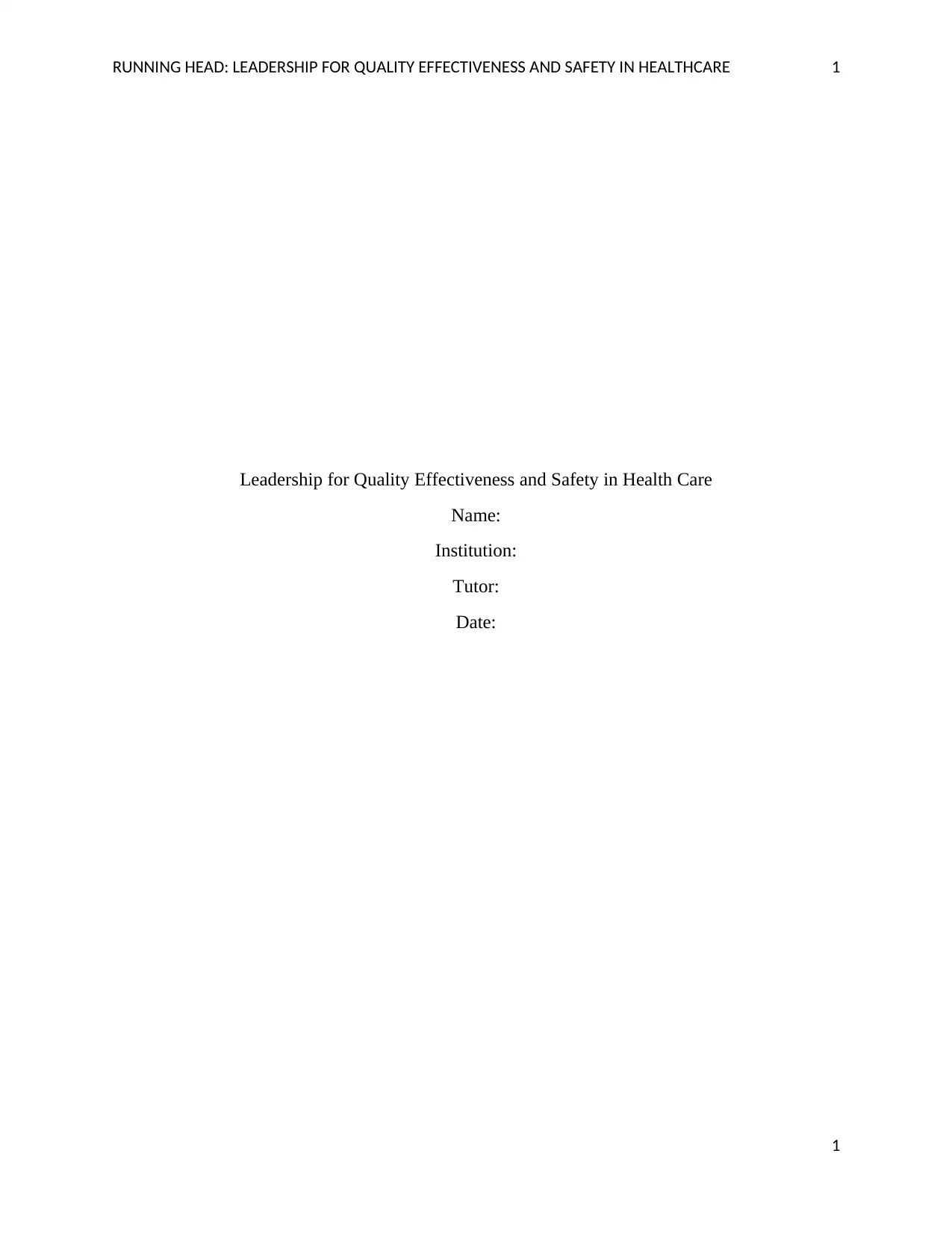
RUNNING HEAD: LEADERSHIP FOR QUALITY EFFECTIVENESS AND SAFETY IN HEALTHCARE 1
Leadership for Quality Effectiveness and Safety in Health Care
Name:
Institution:
Tutor:
Date:
1
Leadership for Quality Effectiveness and Safety in Health Care
Name:
Institution:
Tutor:
Date:
1
Paraphrase This Document
Need a fresh take? Get an instant paraphrase of this document with our AI Paraphraser
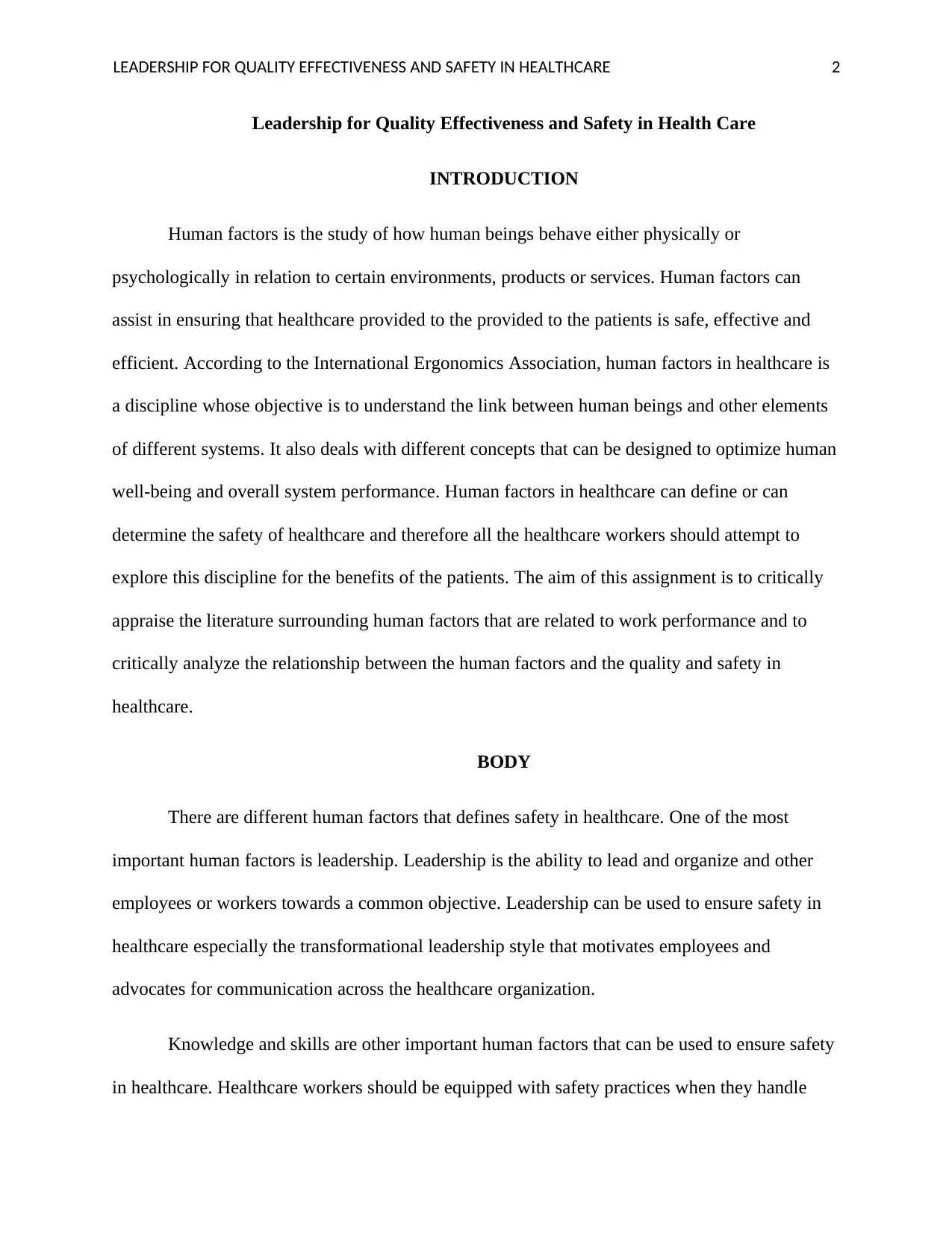
LEADERSHIP FOR QUALITY EFFECTIVENESS AND SAFETY IN HEALTHCARE 2
Leadership for Quality Effectiveness and Safety in Health Care
INTRODUCTION
Human factors is the study of how human beings behave either physically or
psychologically in relation to certain environments, products or services. Human factors can
assist in ensuring that healthcare provided to the provided to the patients is safe, effective and
efficient. According to the International Ergonomics Association, human factors in healthcare is
a discipline whose objective is to understand the link between human beings and other elements
of different systems. It also deals with different concepts that can be designed to optimize human
well-being and overall system performance. Human factors in healthcare can define or can
determine the safety of healthcare and therefore all the healthcare workers should attempt to
explore this discipline for the benefits of the patients. The aim of this assignment is to critically
appraise the literature surrounding human factors that are related to work performance and to
critically analyze the relationship between the human factors and the quality and safety in
healthcare.
BODY
There are different human factors that defines safety in healthcare. One of the most
important human factors is leadership. Leadership is the ability to lead and organize and other
employees or workers towards a common objective. Leadership can be used to ensure safety in
healthcare especially the transformational leadership style that motivates employees and
advocates for communication across the healthcare organization.
Knowledge and skills are other important human factors that can be used to ensure safety
in healthcare. Healthcare workers should be equipped with safety practices when they handle
Leadership for Quality Effectiveness and Safety in Health Care
INTRODUCTION
Human factors is the study of how human beings behave either physically or
psychologically in relation to certain environments, products or services. Human factors can
assist in ensuring that healthcare provided to the provided to the patients is safe, effective and
efficient. According to the International Ergonomics Association, human factors in healthcare is
a discipline whose objective is to understand the link between human beings and other elements
of different systems. It also deals with different concepts that can be designed to optimize human
well-being and overall system performance. Human factors in healthcare can define or can
determine the safety of healthcare and therefore all the healthcare workers should attempt to
explore this discipline for the benefits of the patients. The aim of this assignment is to critically
appraise the literature surrounding human factors that are related to work performance and to
critically analyze the relationship between the human factors and the quality and safety in
healthcare.
BODY
There are different human factors that defines safety in healthcare. One of the most
important human factors is leadership. Leadership is the ability to lead and organize and other
employees or workers towards a common objective. Leadership can be used to ensure safety in
healthcare especially the transformational leadership style that motivates employees and
advocates for communication across the healthcare organization.
Knowledge and skills are other important human factors that can be used to ensure safety
in healthcare. Healthcare workers should be equipped with safety practices when they handle
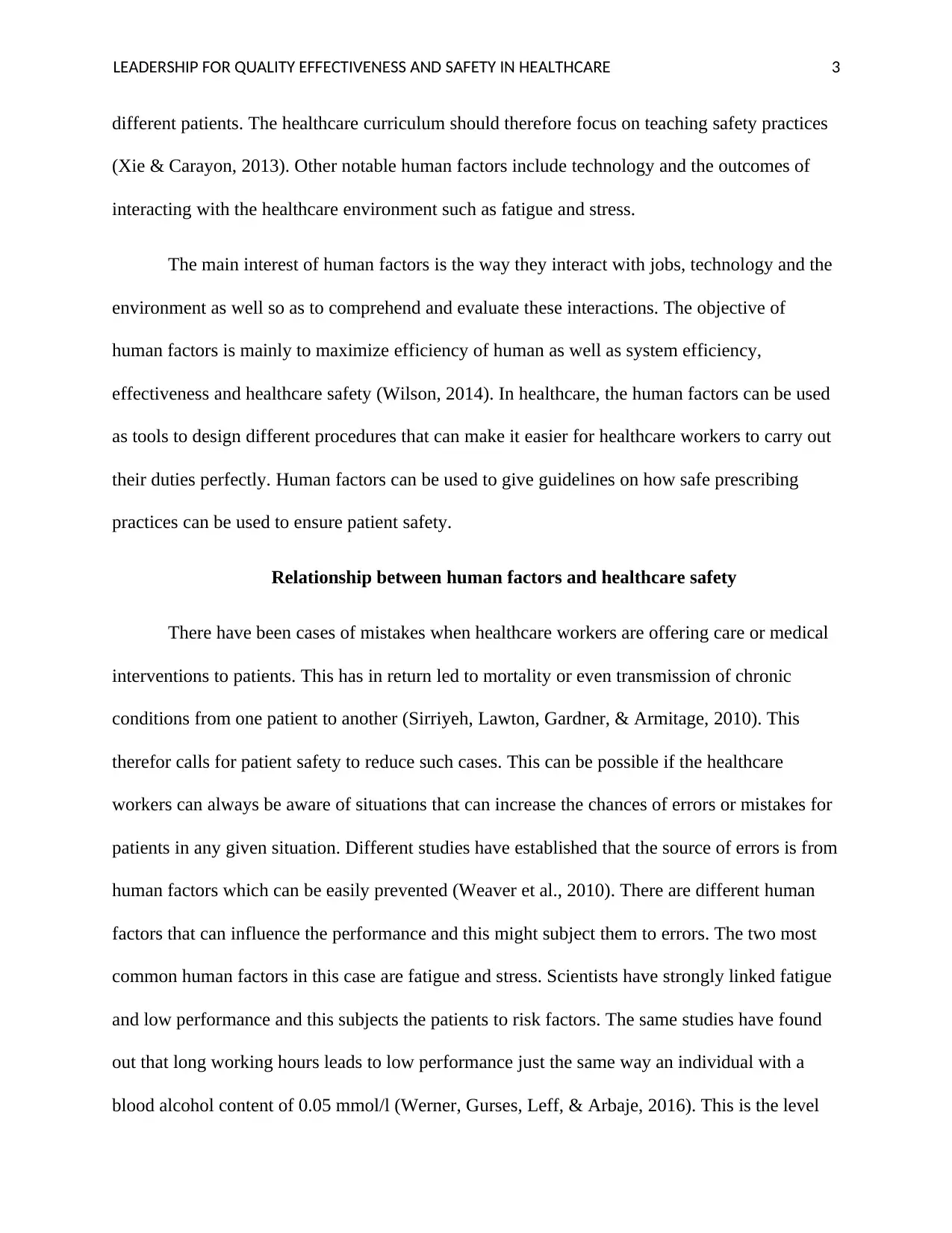
LEADERSHIP FOR QUALITY EFFECTIVENESS AND SAFETY IN HEALTHCARE 3
different patients. The healthcare curriculum should therefore focus on teaching safety practices
(Xie & Carayon, 2013). Other notable human factors include technology and the outcomes of
interacting with the healthcare environment such as fatigue and stress.
The main interest of human factors is the way they interact with jobs, technology and the
environment as well so as to comprehend and evaluate these interactions. The objective of
human factors is mainly to maximize efficiency of human as well as system efficiency,
effectiveness and healthcare safety (Wilson, 2014). In healthcare, the human factors can be used
as tools to design different procedures that can make it easier for healthcare workers to carry out
their duties perfectly. Human factors can be used to give guidelines on how safe prescribing
practices can be used to ensure patient safety.
Relationship between human factors and healthcare safety
There have been cases of mistakes when healthcare workers are offering care or medical
interventions to patients. This has in return led to mortality or even transmission of chronic
conditions from one patient to another (Sirriyeh, Lawton, Gardner, & Armitage, 2010). This
therefor calls for patient safety to reduce such cases. This can be possible if the healthcare
workers can always be aware of situations that can increase the chances of errors or mistakes for
patients in any given situation. Different studies have established that the source of errors is from
human factors which can be easily prevented (Weaver et al., 2010). There are different human
factors that can influence the performance and this might subject them to errors. The two most
common human factors in this case are fatigue and stress. Scientists have strongly linked fatigue
and low performance and this subjects the patients to risk factors. The same studies have found
out that long working hours leads to low performance just the same way an individual with a
blood alcohol content of 0.05 mmol/l (Werner, Gurses, Leff, & Arbaje, 2016). This is the level
different patients. The healthcare curriculum should therefore focus on teaching safety practices
(Xie & Carayon, 2013). Other notable human factors include technology and the outcomes of
interacting with the healthcare environment such as fatigue and stress.
The main interest of human factors is the way they interact with jobs, technology and the
environment as well so as to comprehend and evaluate these interactions. The objective of
human factors is mainly to maximize efficiency of human as well as system efficiency,
effectiveness and healthcare safety (Wilson, 2014). In healthcare, the human factors can be used
as tools to design different procedures that can make it easier for healthcare workers to carry out
their duties perfectly. Human factors can be used to give guidelines on how safe prescribing
practices can be used to ensure patient safety.
Relationship between human factors and healthcare safety
There have been cases of mistakes when healthcare workers are offering care or medical
interventions to patients. This has in return led to mortality or even transmission of chronic
conditions from one patient to another (Sirriyeh, Lawton, Gardner, & Armitage, 2010). This
therefor calls for patient safety to reduce such cases. This can be possible if the healthcare
workers can always be aware of situations that can increase the chances of errors or mistakes for
patients in any given situation. Different studies have established that the source of errors is from
human factors which can be easily prevented (Weaver et al., 2010). There are different human
factors that can influence the performance and this might subject them to errors. The two most
common human factors in this case are fatigue and stress. Scientists have strongly linked fatigue
and low performance and this subjects the patients to risk factors. The same studies have found
out that long working hours leads to low performance just the same way an individual with a
blood alcohol content of 0.05 mmol/l (Werner, Gurses, Leff, & Arbaje, 2016). This is the level
⊘ This is a preview!⊘
Do you want full access?
Subscribe today to unlock all pages.

Trusted by 1+ million students worldwide
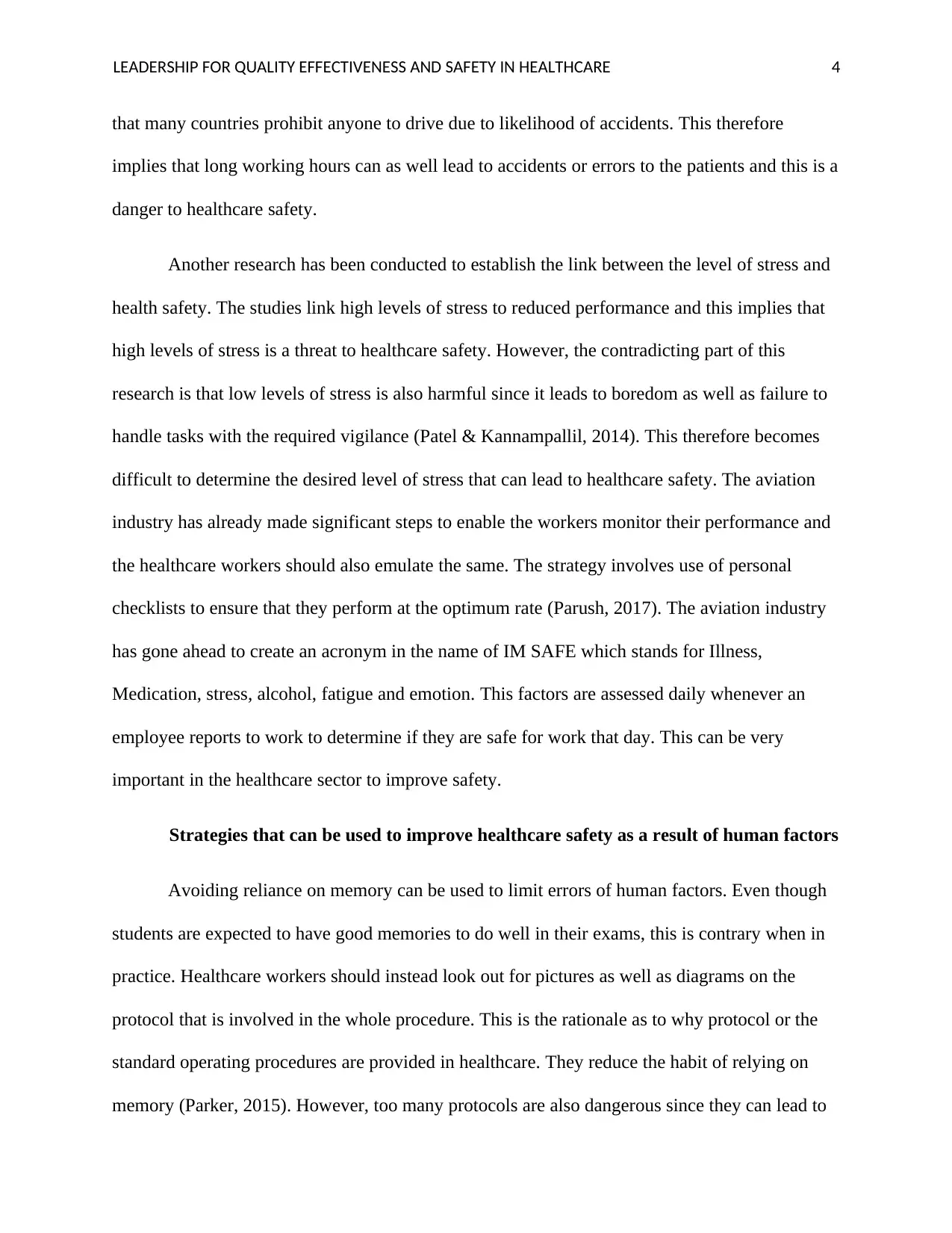
LEADERSHIP FOR QUALITY EFFECTIVENESS AND SAFETY IN HEALTHCARE 4
that many countries prohibit anyone to drive due to likelihood of accidents. This therefore
implies that long working hours can as well lead to accidents or errors to the patients and this is a
danger to healthcare safety.
Another research has been conducted to establish the link between the level of stress and
health safety. The studies link high levels of stress to reduced performance and this implies that
high levels of stress is a threat to healthcare safety. However, the contradicting part of this
research is that low levels of stress is also harmful since it leads to boredom as well as failure to
handle tasks with the required vigilance (Patel & Kannampallil, 2014). This therefore becomes
difficult to determine the desired level of stress that can lead to healthcare safety. The aviation
industry has already made significant steps to enable the workers monitor their performance and
the healthcare workers should also emulate the same. The strategy involves use of personal
checklists to ensure that they perform at the optimum rate (Parush, 2017). The aviation industry
has gone ahead to create an acronym in the name of IM SAFE which stands for Illness,
Medication, stress, alcohol, fatigue and emotion. This factors are assessed daily whenever an
employee reports to work to determine if they are safe for work that day. This can be very
important in the healthcare sector to improve safety.
Strategies that can be used to improve healthcare safety as a result of human factors
Avoiding reliance on memory can be used to limit errors of human factors. Even though
students are expected to have good memories to do well in their exams, this is contrary when in
practice. Healthcare workers should instead look out for pictures as well as diagrams on the
protocol that is involved in the whole procedure. This is the rationale as to why protocol or the
standard operating procedures are provided in healthcare. They reduce the habit of relying on
memory (Parker, 2015). However, too many protocols are also dangerous since they can lead to
that many countries prohibit anyone to drive due to likelihood of accidents. This therefore
implies that long working hours can as well lead to accidents or errors to the patients and this is a
danger to healthcare safety.
Another research has been conducted to establish the link between the level of stress and
health safety. The studies link high levels of stress to reduced performance and this implies that
high levels of stress is a threat to healthcare safety. However, the contradicting part of this
research is that low levels of stress is also harmful since it leads to boredom as well as failure to
handle tasks with the required vigilance (Patel & Kannampallil, 2014). This therefore becomes
difficult to determine the desired level of stress that can lead to healthcare safety. The aviation
industry has already made significant steps to enable the workers monitor their performance and
the healthcare workers should also emulate the same. The strategy involves use of personal
checklists to ensure that they perform at the optimum rate (Parush, 2017). The aviation industry
has gone ahead to create an acronym in the name of IM SAFE which stands for Illness,
Medication, stress, alcohol, fatigue and emotion. This factors are assessed daily whenever an
employee reports to work to determine if they are safe for work that day. This can be very
important in the healthcare sector to improve safety.
Strategies that can be used to improve healthcare safety as a result of human factors
Avoiding reliance on memory can be used to limit errors of human factors. Even though
students are expected to have good memories to do well in their exams, this is contrary when in
practice. Healthcare workers should instead look out for pictures as well as diagrams on the
protocol that is involved in the whole procedure. This is the rationale as to why protocol or the
standard operating procedures are provided in healthcare. They reduce the habit of relying on
memory (Parker, 2015). However, too many protocols are also dangerous since they can lead to
Paraphrase This Document
Need a fresh take? Get an instant paraphrase of this document with our AI Paraphraser
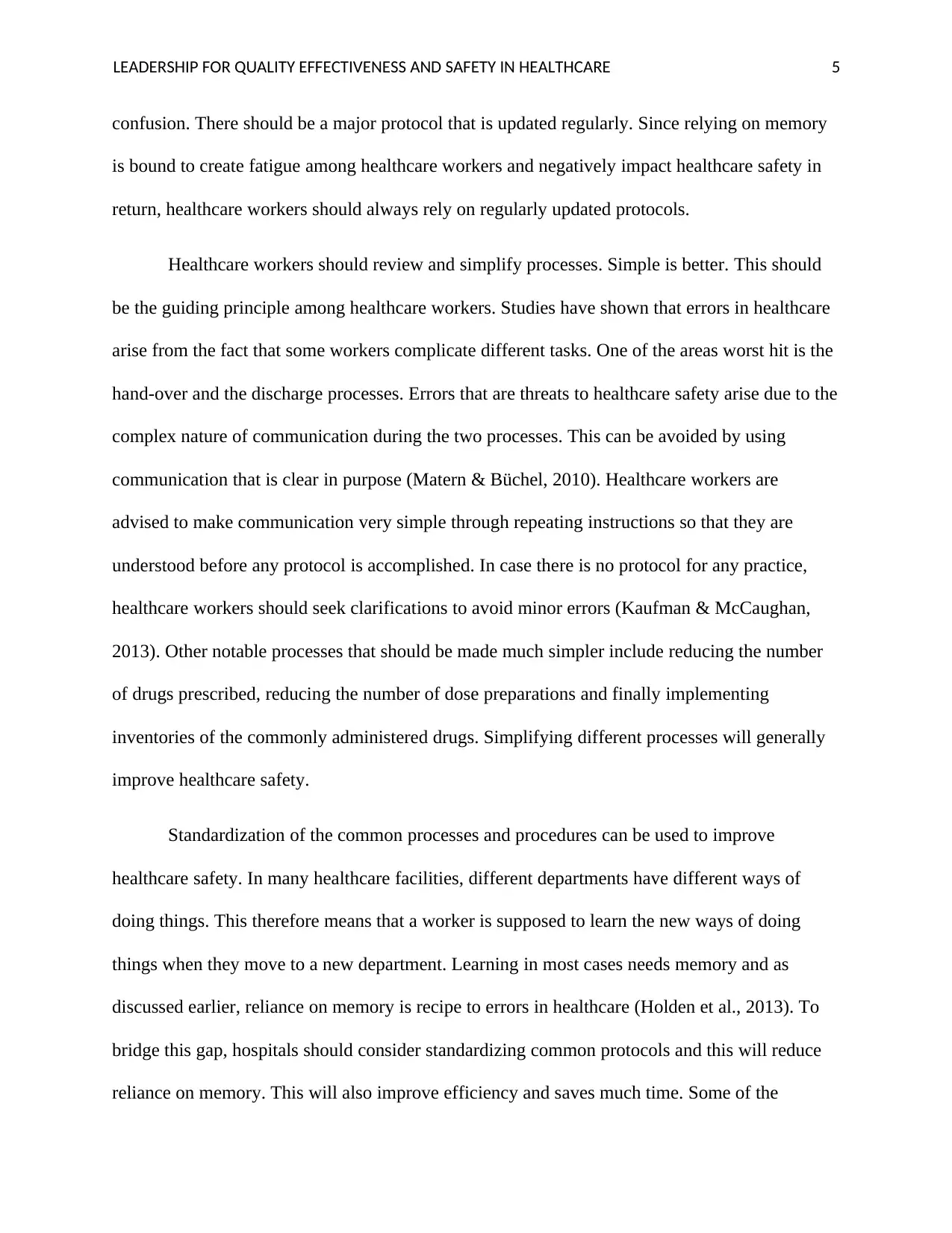
LEADERSHIP FOR QUALITY EFFECTIVENESS AND SAFETY IN HEALTHCARE 5
confusion. There should be a major protocol that is updated regularly. Since relying on memory
is bound to create fatigue among healthcare workers and negatively impact healthcare safety in
return, healthcare workers should always rely on regularly updated protocols.
Healthcare workers should review and simplify processes. Simple is better. This should
be the guiding principle among healthcare workers. Studies have shown that errors in healthcare
arise from the fact that some workers complicate different tasks. One of the areas worst hit is the
hand-over and the discharge processes. Errors that are threats to healthcare safety arise due to the
complex nature of communication during the two processes. This can be avoided by using
communication that is clear in purpose (Matern & Büchel, 2010). Healthcare workers are
advised to make communication very simple through repeating instructions so that they are
understood before any protocol is accomplished. In case there is no protocol for any practice,
healthcare workers should seek clarifications to avoid minor errors (Kaufman & McCaughan,
2013). Other notable processes that should be made much simpler include reducing the number
of drugs prescribed, reducing the number of dose preparations and finally implementing
inventories of the commonly administered drugs. Simplifying different processes will generally
improve healthcare safety.
Standardization of the common processes and procedures can be used to improve
healthcare safety. In many healthcare facilities, different departments have different ways of
doing things. This therefore means that a worker is supposed to learn the new ways of doing
things when they move to a new department. Learning in most cases needs memory and as
discussed earlier, reliance on memory is recipe to errors in healthcare (Holden et al., 2013). To
bridge this gap, hospitals should consider standardizing common protocols and this will reduce
reliance on memory. This will also improve efficiency and saves much time. Some of the
confusion. There should be a major protocol that is updated regularly. Since relying on memory
is bound to create fatigue among healthcare workers and negatively impact healthcare safety in
return, healthcare workers should always rely on regularly updated protocols.
Healthcare workers should review and simplify processes. Simple is better. This should
be the guiding principle among healthcare workers. Studies have shown that errors in healthcare
arise from the fact that some workers complicate different tasks. One of the areas worst hit is the
hand-over and the discharge processes. Errors that are threats to healthcare safety arise due to the
complex nature of communication during the two processes. This can be avoided by using
communication that is clear in purpose (Matern & Büchel, 2010). Healthcare workers are
advised to make communication very simple through repeating instructions so that they are
understood before any protocol is accomplished. In case there is no protocol for any practice,
healthcare workers should seek clarifications to avoid minor errors (Kaufman & McCaughan,
2013). Other notable processes that should be made much simpler include reducing the number
of drugs prescribed, reducing the number of dose preparations and finally implementing
inventories of the commonly administered drugs. Simplifying different processes will generally
improve healthcare safety.
Standardization of the common processes and procedures can be used to improve
healthcare safety. In many healthcare facilities, different departments have different ways of
doing things. This therefore means that a worker is supposed to learn the new ways of doing
things when they move to a new department. Learning in most cases needs memory and as
discussed earlier, reliance on memory is recipe to errors in healthcare (Holden et al., 2013). To
bridge this gap, hospitals should consider standardizing common protocols and this will reduce
reliance on memory. This will also improve efficiency and saves much time. Some of the
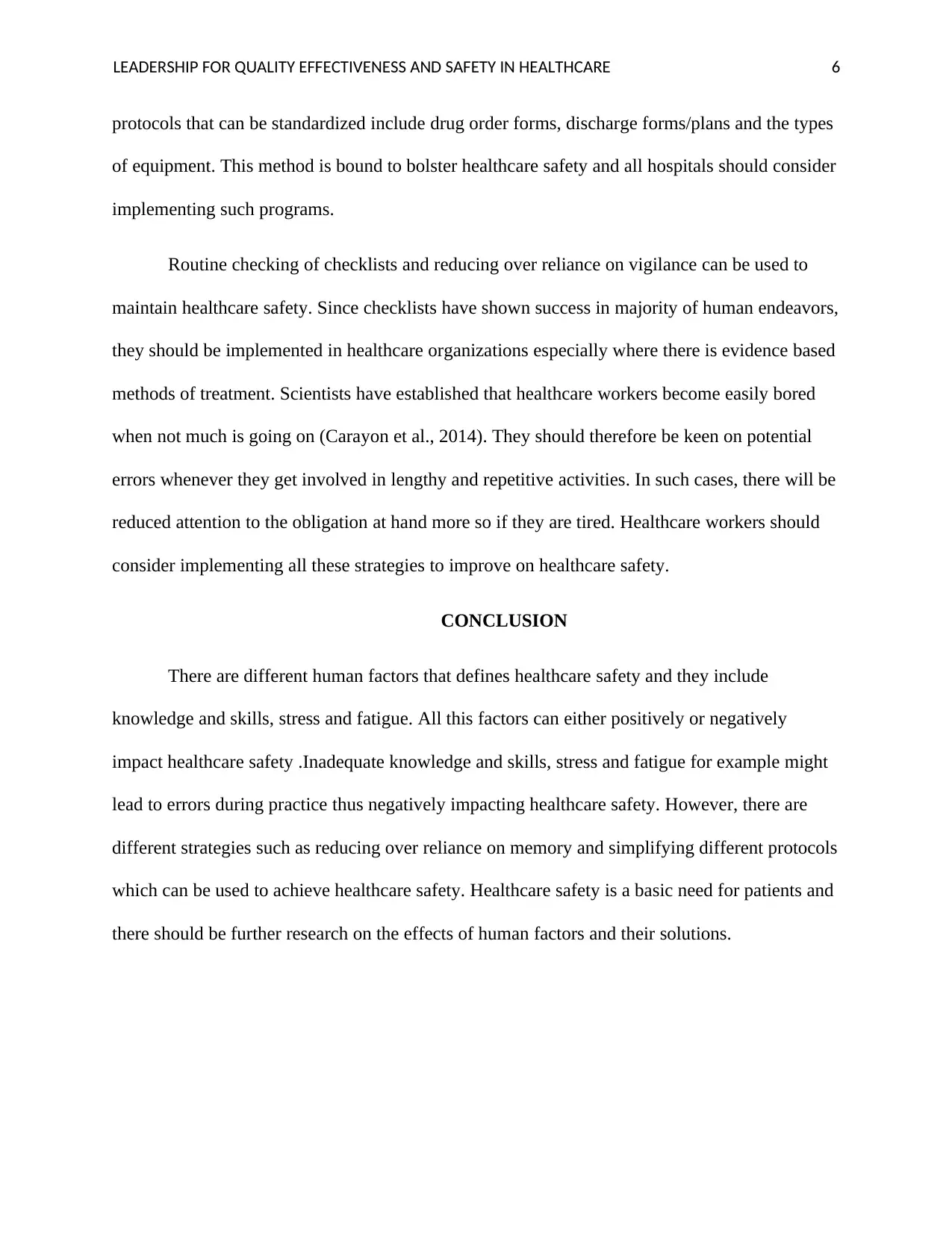
LEADERSHIP FOR QUALITY EFFECTIVENESS AND SAFETY IN HEALTHCARE 6
protocols that can be standardized include drug order forms, discharge forms/plans and the types
of equipment. This method is bound to bolster healthcare safety and all hospitals should consider
implementing such programs.
Routine checking of checklists and reducing over reliance on vigilance can be used to
maintain healthcare safety. Since checklists have shown success in majority of human endeavors,
they should be implemented in healthcare organizations especially where there is evidence based
methods of treatment. Scientists have established that healthcare workers become easily bored
when not much is going on (Carayon et al., 2014). They should therefore be keen on potential
errors whenever they get involved in lengthy and repetitive activities. In such cases, there will be
reduced attention to the obligation at hand more so if they are tired. Healthcare workers should
consider implementing all these strategies to improve on healthcare safety.
CONCLUSION
There are different human factors that defines healthcare safety and they include
knowledge and skills, stress and fatigue. All this factors can either positively or negatively
impact healthcare safety .Inadequate knowledge and skills, stress and fatigue for example might
lead to errors during practice thus negatively impacting healthcare safety. However, there are
different strategies such as reducing over reliance on memory and simplifying different protocols
which can be used to achieve healthcare safety. Healthcare safety is a basic need for patients and
there should be further research on the effects of human factors and their solutions.
protocols that can be standardized include drug order forms, discharge forms/plans and the types
of equipment. This method is bound to bolster healthcare safety and all hospitals should consider
implementing such programs.
Routine checking of checklists and reducing over reliance on vigilance can be used to
maintain healthcare safety. Since checklists have shown success in majority of human endeavors,
they should be implemented in healthcare organizations especially where there is evidence based
methods of treatment. Scientists have established that healthcare workers become easily bored
when not much is going on (Carayon et al., 2014). They should therefore be keen on potential
errors whenever they get involved in lengthy and repetitive activities. In such cases, there will be
reduced attention to the obligation at hand more so if they are tired. Healthcare workers should
consider implementing all these strategies to improve on healthcare safety.
CONCLUSION
There are different human factors that defines healthcare safety and they include
knowledge and skills, stress and fatigue. All this factors can either positively or negatively
impact healthcare safety .Inadequate knowledge and skills, stress and fatigue for example might
lead to errors during practice thus negatively impacting healthcare safety. However, there are
different strategies such as reducing over reliance on memory and simplifying different protocols
which can be used to achieve healthcare safety. Healthcare safety is a basic need for patients and
there should be further research on the effects of human factors and their solutions.
⊘ This is a preview!⊘
Do you want full access?
Subscribe today to unlock all pages.

Trusted by 1+ million students worldwide
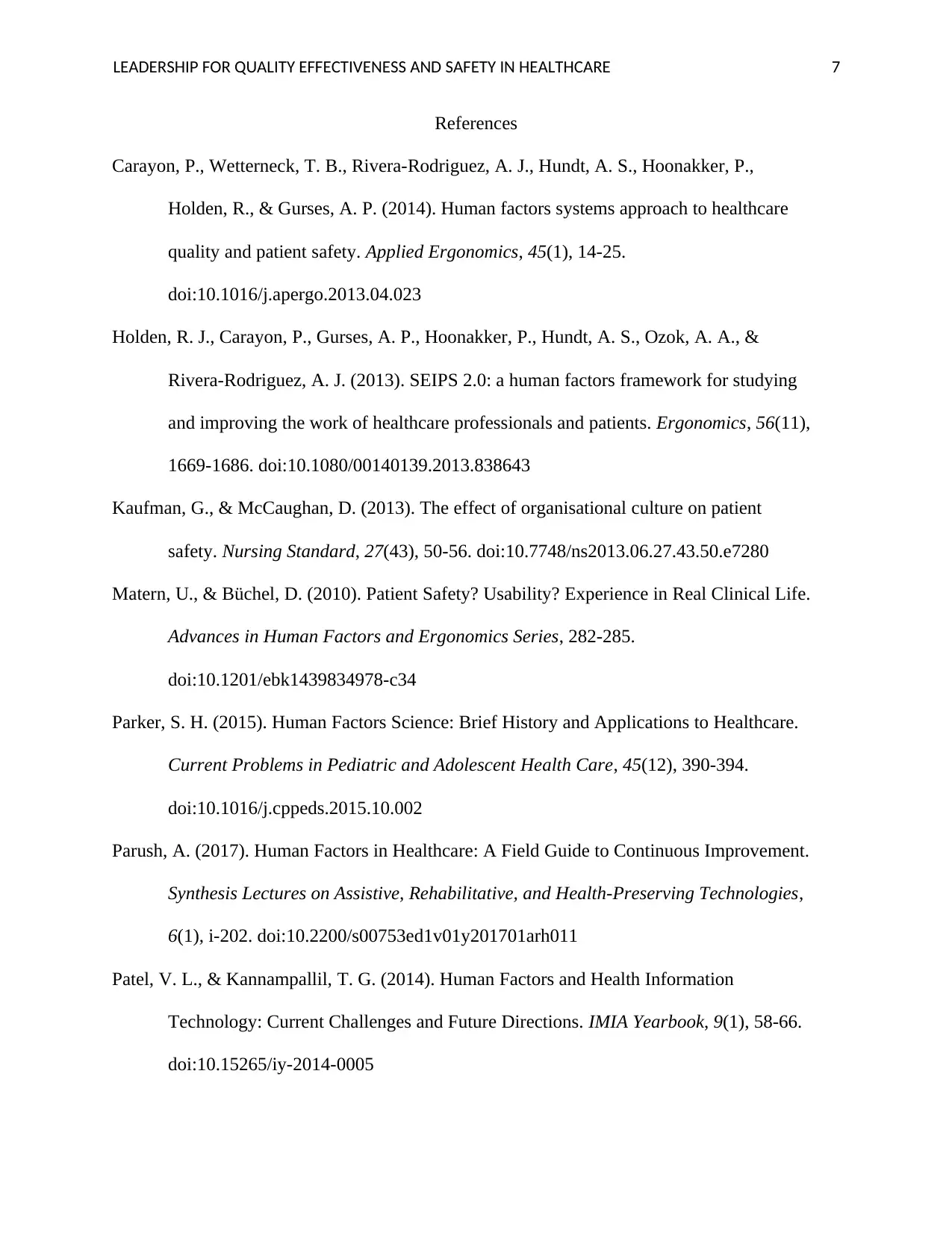
LEADERSHIP FOR QUALITY EFFECTIVENESS AND SAFETY IN HEALTHCARE 7
References
Carayon, P., Wetterneck, T. B., Rivera-Rodriguez, A. J., Hundt, A. S., Hoonakker, P.,
Holden, R., & Gurses, A. P. (2014). Human factors systems approach to healthcare
quality and patient safety. Applied Ergonomics, 45(1), 14-25.
doi:10.1016/j.apergo.2013.04.023
Holden, R. J., Carayon, P., Gurses, A. P., Hoonakker, P., Hundt, A. S., Ozok, A. A., &
Rivera-Rodriguez, A. J. (2013). SEIPS 2.0: a human factors framework for studying
and improving the work of healthcare professionals and patients. Ergonomics, 56(11),
1669-1686. doi:10.1080/00140139.2013.838643
Kaufman, G., & McCaughan, D. (2013). The effect of organisational culture on patient
safety. Nursing Standard, 27(43), 50-56. doi:10.7748/ns2013.06.27.43.50.e7280
Matern, U., & Büchel, D. (2010). Patient Safety? Usability? Experience in Real Clinical Life.
Advances in Human Factors and Ergonomics Series, 282-285.
doi:10.1201/ebk1439834978-c34
Parker, S. H. (2015). Human Factors Science: Brief History and Applications to Healthcare.
Current Problems in Pediatric and Adolescent Health Care, 45(12), 390-394.
doi:10.1016/j.cppeds.2015.10.002
Parush, A. (2017). Human Factors in Healthcare: A Field Guide to Continuous Improvement.
Synthesis Lectures on Assistive, Rehabilitative, and Health-Preserving Technologies,
6(1), i-202. doi:10.2200/s00753ed1v01y201701arh011
Patel, V. L., & Kannampallil, T. G. (2014). Human Factors and Health Information
Technology: Current Challenges and Future Directions. IMIA Yearbook, 9(1), 58-66.
doi:10.15265/iy-2014-0005
References
Carayon, P., Wetterneck, T. B., Rivera-Rodriguez, A. J., Hundt, A. S., Hoonakker, P.,
Holden, R., & Gurses, A. P. (2014). Human factors systems approach to healthcare
quality and patient safety. Applied Ergonomics, 45(1), 14-25.
doi:10.1016/j.apergo.2013.04.023
Holden, R. J., Carayon, P., Gurses, A. P., Hoonakker, P., Hundt, A. S., Ozok, A. A., &
Rivera-Rodriguez, A. J. (2013). SEIPS 2.0: a human factors framework for studying
and improving the work of healthcare professionals and patients. Ergonomics, 56(11),
1669-1686. doi:10.1080/00140139.2013.838643
Kaufman, G., & McCaughan, D. (2013). The effect of organisational culture on patient
safety. Nursing Standard, 27(43), 50-56. doi:10.7748/ns2013.06.27.43.50.e7280
Matern, U., & Büchel, D. (2010). Patient Safety? Usability? Experience in Real Clinical Life.
Advances in Human Factors and Ergonomics Series, 282-285.
doi:10.1201/ebk1439834978-c34
Parker, S. H. (2015). Human Factors Science: Brief History and Applications to Healthcare.
Current Problems in Pediatric and Adolescent Health Care, 45(12), 390-394.
doi:10.1016/j.cppeds.2015.10.002
Parush, A. (2017). Human Factors in Healthcare: A Field Guide to Continuous Improvement.
Synthesis Lectures on Assistive, Rehabilitative, and Health-Preserving Technologies,
6(1), i-202. doi:10.2200/s00753ed1v01y201701arh011
Patel, V. L., & Kannampallil, T. G. (2014). Human Factors and Health Information
Technology: Current Challenges and Future Directions. IMIA Yearbook, 9(1), 58-66.
doi:10.15265/iy-2014-0005
Paraphrase This Document
Need a fresh take? Get an instant paraphrase of this document with our AI Paraphraser
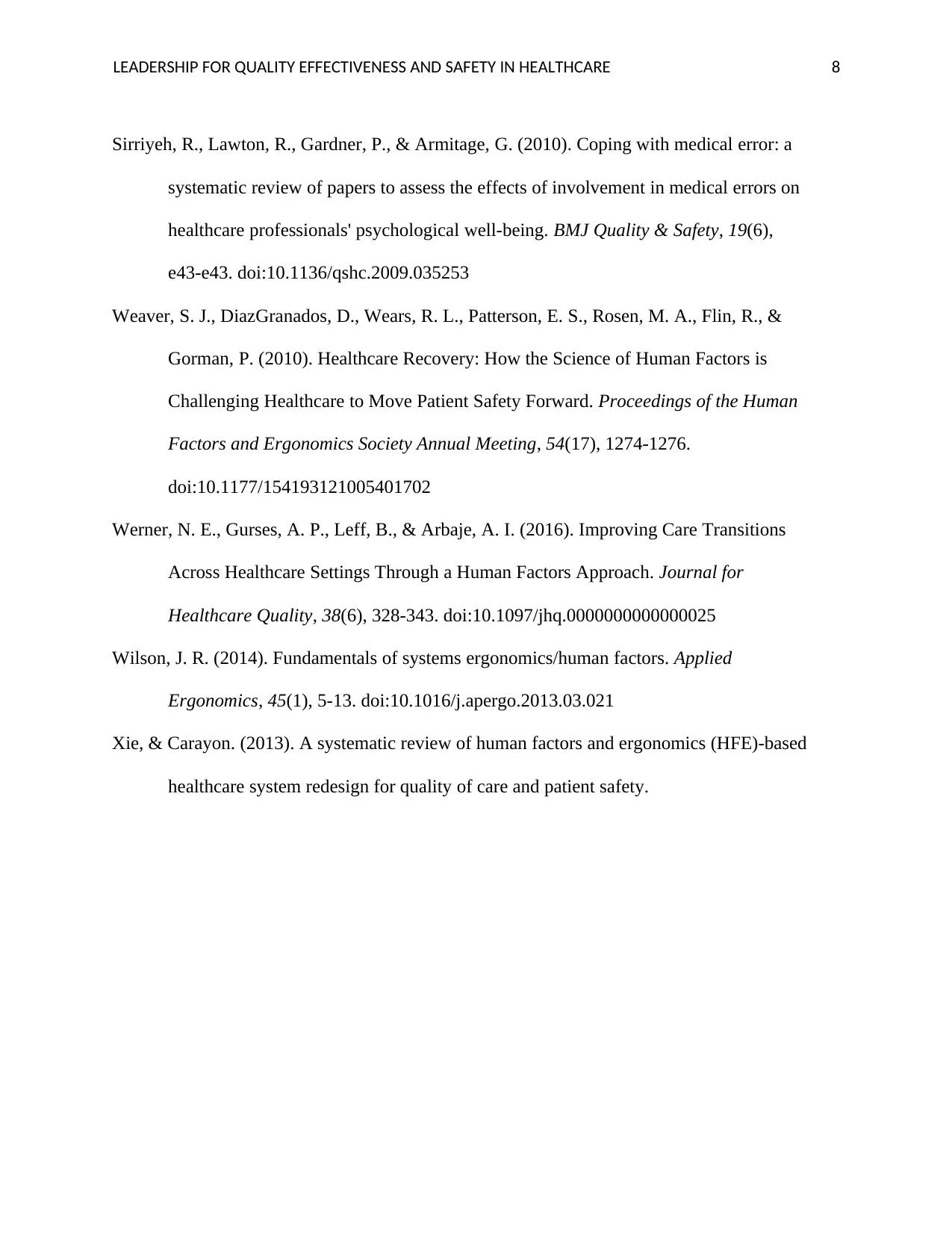
LEADERSHIP FOR QUALITY EFFECTIVENESS AND SAFETY IN HEALTHCARE 8
Sirriyeh, R., Lawton, R., Gardner, P., & Armitage, G. (2010). Coping with medical error: a
systematic review of papers to assess the effects of involvement in medical errors on
healthcare professionals' psychological well-being. BMJ Quality & Safety, 19(6),
e43-e43. doi:10.1136/qshc.2009.035253
Weaver, S. J., DiazGranados, D., Wears, R. L., Patterson, E. S., Rosen, M. A., Flin, R., &
Gorman, P. (2010). Healthcare Recovery: How the Science of Human Factors is
Challenging Healthcare to Move Patient Safety Forward. Proceedings of the Human
Factors and Ergonomics Society Annual Meeting, 54(17), 1274-1276.
doi:10.1177/154193121005401702
Werner, N. E., Gurses, A. P., Leff, B., & Arbaje, A. I. (2016). Improving Care Transitions
Across Healthcare Settings Through a Human Factors Approach. Journal for
Healthcare Quality, 38(6), 328-343. doi:10.1097/jhq.0000000000000025
Wilson, J. R. (2014). Fundamentals of systems ergonomics/human factors. Applied
Ergonomics, 45(1), 5-13. doi:10.1016/j.apergo.2013.03.021
Xie, & Carayon. (2013). A systematic review of human factors and ergonomics (HFE)-based
healthcare system redesign for quality of care and patient safety.
Sirriyeh, R., Lawton, R., Gardner, P., & Armitage, G. (2010). Coping with medical error: a
systematic review of papers to assess the effects of involvement in medical errors on
healthcare professionals' psychological well-being. BMJ Quality & Safety, 19(6),
e43-e43. doi:10.1136/qshc.2009.035253
Weaver, S. J., DiazGranados, D., Wears, R. L., Patterson, E. S., Rosen, M. A., Flin, R., &
Gorman, P. (2010). Healthcare Recovery: How the Science of Human Factors is
Challenging Healthcare to Move Patient Safety Forward. Proceedings of the Human
Factors and Ergonomics Society Annual Meeting, 54(17), 1274-1276.
doi:10.1177/154193121005401702
Werner, N. E., Gurses, A. P., Leff, B., & Arbaje, A. I. (2016). Improving Care Transitions
Across Healthcare Settings Through a Human Factors Approach. Journal for
Healthcare Quality, 38(6), 328-343. doi:10.1097/jhq.0000000000000025
Wilson, J. R. (2014). Fundamentals of systems ergonomics/human factors. Applied
Ergonomics, 45(1), 5-13. doi:10.1016/j.apergo.2013.03.021
Xie, & Carayon. (2013). A systematic review of human factors and ergonomics (HFE)-based
healthcare system redesign for quality of care and patient safety.
1 out of 8
Related Documents
Your All-in-One AI-Powered Toolkit for Academic Success.
+13062052269
info@desklib.com
Available 24*7 on WhatsApp / Email
![[object Object]](/_next/static/media/star-bottom.7253800d.svg)
Unlock your academic potential
Copyright © 2020–2025 A2Z Services. All Rights Reserved. Developed and managed by ZUCOL.




